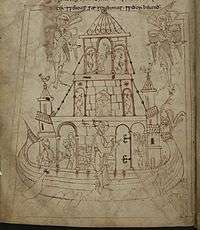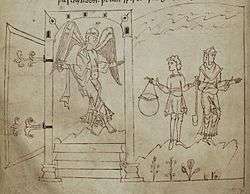Cædmon manuscript

MS Junius 11 (Cædmon, Junius manuscript or Junius manuscript of Oxford) is one of the four major codices of Old English literature. Although the poems are untitled in the manuscript, modern editors have provided the names Genesis A, Genesis B, Exodus, Daniel, and Christ and Satan.
The manuscript is in the Bodleian Library at the University of Oxford.
Name and date

The popular name of the codex is the Cædmon manuscript, after an early theory that the poems it contains might be the work of Cædmon; the name has stuck even though the theory is no longer considered credible. In more recent works it is commonly referred to either by its Bodleian designation MS Junius 11, or as the Junius manuscript or Codex Junius; 'Junius' here is Franciscus Junius, who published the first edition of its contents in 1655.
It has been established on palaeographical grounds that compilation of the manuscript began c. AD 1000. Recent work has suggested an earlier, narrow window for the likely compilation date to 930-960, based on a coincidence of the style of illustrations.
The compilation was in two stages: the initial version of the manuscript contained Genesis, Exodus, and Daniel, and was the work of a single scribe. Later the final poem, Christ and Satan, was added by several other scribes. The manuscript contains numerous illustrations that are a fine demonstration of Anglo-Saxon drawing on religious topics; it appears that two illustrators worked independently on the manuscript. The first scribe left spaces in the text for other illustrations which were never completed.
Illustrations
The manuscript is partly illustrated with a series of line drawings depicting the events in the text. From spaces left by the scribes, it appears that it was intended that the manuscript be fully illustrated; in the event, the work was left unfinished after only about a third of the artwork had been drawn. This scheme of illustrations, which is unparalleled in other manuscripts of Anglo-Saxon poetry, implies that the manuscript was conceived of as being considerably more important than most vernacular texts; it may have been intended for devotional or didactic use.
Contents
The names of the poems themselves are modern inventions; they are not given titles in the manuscript. As with the majority of Anglo-Saxon writing, the poems are anonymous and their provenance and dating are uncertain.
Genesis

Genesis is a paraphrase of the first part of the biblical book of Genesis, from the Creation through to the test of Abraham's faith with the sacrifice of Isaac (Gen. 22).
The work is now recognised as a composite work formed of two originally distinct parts, conventionally referred to as Genesis A and Genesis B; the latter, lines 235-851 of the poem as we have it, appears to have been interpolated into an older poem to produce the current text.
It is Genesis B which has attracted the most critical attention. Its origin is notable in that it appears to be a translation from a 9th-century Old Saxon original; this theory was originally made on metrical grounds, and then confirmed by the discovery of a fragment of Old Saxon verse that appears to correspond to part of the work. In 1875 the German scholar Sievers was first to show that these lines differ from the rest in meter. This view was confirmed later in 1894. The writer of the interpolated passage most probably the German may have lacked Cædmon's craftsmanship but his genius was great. Thematically and stylistically, too, it is distinctive: it tells the story of the falls of Satan and Man in an epic style, and has been suggested as an influence for Beowulf, and even perhaps for Paradise Lost.
Exodus
Exodus is not a paraphrase of the biblical book, but rather a retelling of the story of the Israelites' Flight from Egypt and the Crossing of the Red Sea in the manner of a "heroic epic", much like Old English poems Andreas, Judith, or even the non-religious Beowulf. It is one of the densest, most allusive and complex poems in Old English, and is the focus of much critical debate.
Exodus brings a traditional "heroic style" to its biblical subject-matter. Moses is treated as a general, and military imagery pervades the battle scenes. The destruction of the Egyptians in the Red Sea is narrated in much the same way as a formulaic battle scene from other Old English poems, including a 'Beast of Battle' motif very common in the poetry.
The main story is suspended at one point to tell the stories of Noah and Abraham's sacrifice of Isaac. Some scholars consider this change of subject a feature of the "epic style" comparable with the similar digressions in Beowulf, while others have proposed it is a later interpolation. Edward B. Irving edited the poem twice, 1955 and 1981: the first edition excerpted the Noah and Abraham portion as a separate poem; on later reflection, Irving recanted, admitting it was an integrated part of the Exodus poem. There appears to be justification in patristic sermons for connecting the crossing of the Red Sea with these topics.
In recent decades, attention has shifted away from the "heroic" aspects of Exodus to consider its densely allusive structure and possible typology. Peter J. Lucas, for instance, has argued that the poem is an allegorical treatment of the Christian's fight with the devil. The Crossing of the Red Sea has been seen as echoing the Baptismal liturgy and prefiguring the entrance into Heaven. The Pharaoh may be associated with Satan through some subtle verbal echoes. However, these readings are still controversial and much-debated. A more balanced view would accept that though certain intermittent parts of the narrative of Exodus merge into typological allusion, this is not sustained throughout the poem.
Daniel
A short paraphrase of the book of Daniel, dwelling particularly on the story of the Fiery Furnace, deals with the first five chapters of the Book of Daniel.
Christ and Satan
A three-part poem detailing the Fall of Satan, Christ's harrowing of Hell (from the Apocryphal New Testament Gospel of Nicodemus), and Christ's temptation in the desert.
Facsimiles
Digital facsimiles are available online and offline: A complete digital facsimile with copious annotations, transcriptions and translations was released on CD format in 2004:
- Muir, Bernard J., ed. (2004), A Digital Facsimile of Oxford, Bodleian Library, MS. Junius 11 (CD-ROM; software by Nick Kennedy), Oxford: Bodleian Library, University of Oxford
- A complete digital facsimile is online at Early Manuscripts at Oxford University
Further literature
- Broderick, Herbert (1983). "Observations on the Method of Illustration in MS Junius 11 and the Relationship of the Drawings to the Text". Scriptorium. 37 (2): 161–177, with plate 2.
- Broderick, Herbert (2009). "Metatextuality, Sexuality, and Intervisuality in MS Junius 11". Word and Image. 25 (4): 384–400. doi:10.1080/02666280902717262.
- Karkov, Catherine E. (2001). Text and Picture in Anglo-Saxon England: Narrative Strategies in the Junius 11 Manuscript. Cambridge Studies in Anglo-Saxon England. 31. Cambridge, UK: Cambridge University Press. ISBN 978-0521093064.
- Karkov, Catherine (2007). "Margins and Marginalization: Representations of Eve in Oxford, Bodleian Library, MS Junius 11". In Keefer, Sarah L.; Bremmer, Rolf H. Signs on the Edge. Space, Text and Margin in Medieval Manuscripts. Mediaevalia Groningana New Series. 10. Paris: Peeters. pp. 57–84. ISBN 978-9042919808.
- Lockett, Leslie (2002). "An Integrated Re-examination of the Dating of Oxford, Bodleian Library, Junius 11". Anglo-Saxon England. 31 (1): 141–173, with plates I–IVc. doi:10.1017/S0263675102000066.
- Ohlgren, Thomas H. (1992). Anglo-Saxon Textual Illustration. Kalamazoo, MI: Medieval Institute, Western Michigan University. ISBN 978-1879288102.
- Raw, Barbara C. (1976). "The Probable Derivation of Most of the Illustrations in Junius 11 from an Illustrated Old Saxon Genesis". Anglo-Saxon England. 5: 133–148, with plates Ia–IV. doi:10.1017/S026367510000082X.
- Raw, Barbara C. (1984). "The Construction of Oxford, Bodleian Library, Junius 11". Anglo-Saxon England. 13: 187–205. doi:10.1017/S0263675100003586.
External links
| Wikimedia Commons has media related to Caedmon manuscript. |
- Wikimedia Commons has 249 images (link at right)
- Bodleian Library
- Encyclopaedia Britannica Cædmon manuscript
- The Gutenberg project contains the Cædmon manuscript; here it is called the Codex Junius
See also
- Anglo-Saxon literature
- Exeter Book
- History of the English Bible
- Nowell Codex
- Old English Bible translations
- Vercelli Book